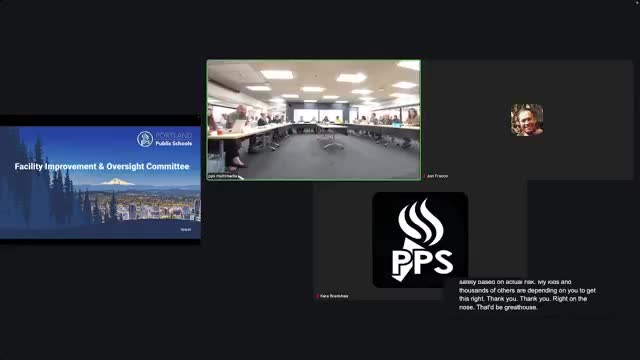Parents and teachers urge stronger HVAC action after mixed results from temporary cooling trial
October 09, 2025 | Portland SD 1J, School Districts, Oregon
This article was created by AI summarizing key points discussed. AI makes mistakes, so for full details and context, please refer to the video of the full meeting. Please report any errors so we can fix them. Report an error »

Parents and teachers at the Facilities Improvement Oversight Committee meeting described uneven results from the district's temporary cooling measures during recent heat events and urged broader, more transparent HVAC planning.
Dr. Effie Greathouse, a parent with the group Safe Indoor Air for Oregon Schools, praised the district's leadership and the placement of temporary cooling equipment in 15 schools, saying savings found in other areas “is potentially another elementary school or middle school getting a desperately needed HVAC overhaul.” She asked the board to make HVAC a standing agenda item every other month to sustain attention and coordination.
Hillary Brown, a physics teacher at Ida B. Wells, said the cafeteria cooling worked but the swamp coolers were “never hooked up to a water source, which is what they require to function,” so some devices only acted as fans and pushed hot air down hallways. Brown also said many of the worst classrooms are on second and third floors and that staff removed the poles and latches needed to open high windows that were part of the building's original natural ventilation.
Emily Davidson, a parent at Jason Lee Elementary, and Katie Price, a parent at Odyssey K‑8, said the temporary equipment sometimes provided relief only in cafeterias or hallways and not in end‑of‑hallway classrooms, including special‑education spaces. Davidson told the committee that over half of classrooms at her school get “less than 2 air changes per hour,” a metric she cited to explain why overnight cooling and ventilation policy matters.
District staff and contractors present acknowledged the pilot was a rapid trial and said the district will analyze feedback and sensor data to guide future equipment choices. Staff also said they are developing better dashboard and communications tools so the public can follow HVAC projects and that some earlier portable AC tests were not configured effectively.
Speakers made three concrete requests: expand trials of different cooling approaches to more schools, install in‑room air quality sensors to guide equipment decisions, and create stronger, more frequent board‑level reporting on HVAC progress. No formal board action was taken at the meeting.
Dr. Effie Greathouse, a parent with the group Safe Indoor Air for Oregon Schools, praised the district's leadership and the placement of temporary cooling equipment in 15 schools, saying savings found in other areas “is potentially another elementary school or middle school getting a desperately needed HVAC overhaul.” She asked the board to make HVAC a standing agenda item every other month to sustain attention and coordination.
Hillary Brown, a physics teacher at Ida B. Wells, said the cafeteria cooling worked but the swamp coolers were “never hooked up to a water source, which is what they require to function,” so some devices only acted as fans and pushed hot air down hallways. Brown also said many of the worst classrooms are on second and third floors and that staff removed the poles and latches needed to open high windows that were part of the building's original natural ventilation.
Emily Davidson, a parent at Jason Lee Elementary, and Katie Price, a parent at Odyssey K‑8, said the temporary equipment sometimes provided relief only in cafeterias or hallways and not in end‑of‑hallway classrooms, including special‑education spaces. Davidson told the committee that over half of classrooms at her school get “less than 2 air changes per hour,” a metric she cited to explain why overnight cooling and ventilation policy matters.
District staff and contractors present acknowledged the pilot was a rapid trial and said the district will analyze feedback and sensor data to guide future equipment choices. Staff also said they are developing better dashboard and communications tools so the public can follow HVAC projects and that some earlier portable AC tests were not configured effectively.
Speakers made three concrete requests: expand trials of different cooling approaches to more schools, install in‑room air quality sensors to guide equipment decisions, and create stronger, more frequent board‑level reporting on HVAC progress. No formal board action was taken at the meeting.
View full meeting
This article is based on a recent meeting—watch the full video and explore the complete transcript for deeper insights into the discussion.
View full meeting
